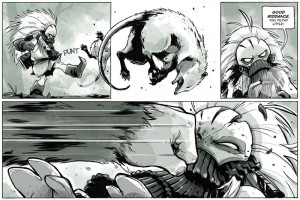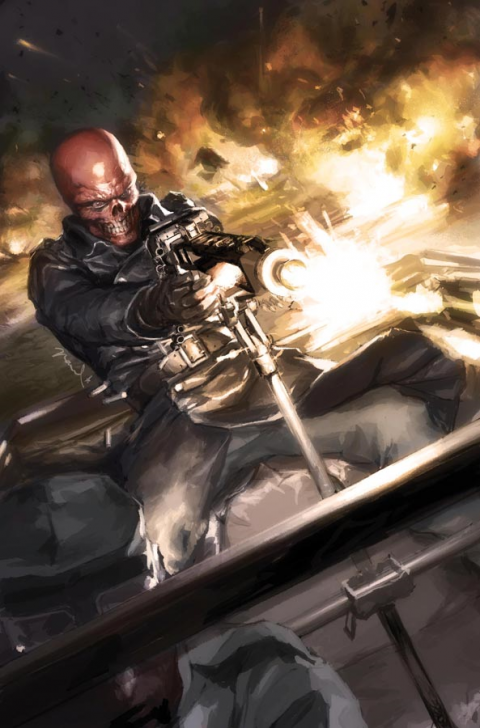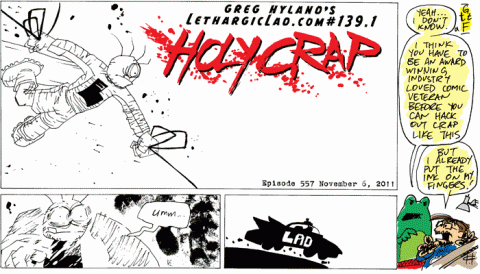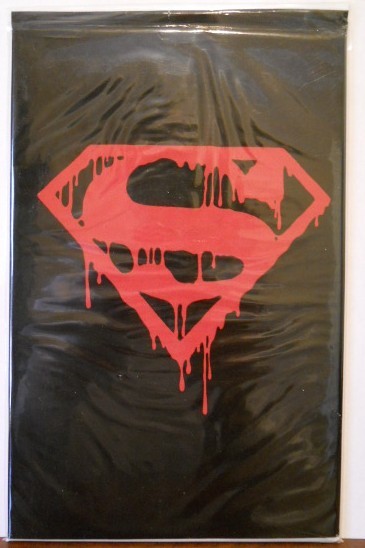Every week Comic Book Daily asks the question and the crew (and special guests) give their answers; we’ll be doing this for 52 weeks. Tip of the hat goes to the gang at Scans Daily for the inspiration and Scott VanderPloeg for this week’s question.
[box type=question]After reading last week’s 52Q answers (I asked who was reading comics digitally) it seemed unanimous that web comics were not considered mainstream or comics. This week I’d like to explore that and ask why not? What defines a comic for you?[/box]
Chris Howard (From Egesta Comics, one of the masterminds behind Dressed For Success)
I never got around to answering last week, suffice is to say I’ve looked at a lot of comics on-screen, many of them so-called “webcomics”. I don’t think the names really mean anything. I’m a Scott McCloud fan. If it walks and talks like comics, then it’s comics. Graphic Novels, Webcomics, Motion Comics, Hyper comics, whatever, it’s all comics. All these other names are just attempts to classify or compartmentalize a particular subset, or just reaching for recognition. A web comic is a comic that is produced primarily on the web? Okay, whatever, cause you can have a print version as well. what happens when I take my former print comic and decide to put it online? Is it a print based web comic now?
I think we are just doing a disservice and confusing people with all these terms. When I talk to people about comics at the library, they are confused about the words comics and graphic novels, they think there is some difference or they wonder what that difference is, because there must be one if there are different words. We need to step up, now that we’ve got the larger world more acclimatized to them, and embrace the word comics. No matter what physical or non-physical form they may take.
Kevin Boyd (Director of the illustrious Joe Shuster Awards Committee)
Comics are generally images placed adjacently in a manner so as to tell some kind of narrative story.
While I do agree with Chris that we are hung up on titles, I don’t think there is any disservice to distinguish comic strips from comic books or graphic novels, or print comics from webcomics, because for the most part print comics are longer narratives and webcomics are gag strips – of course there are exceptions to each. Last week Scott asked if anyone read “digital comics” and that’s a term that’s been co-opted by comic BOOK publishers to describe the content they make available on the web for consumption. When Anthony talks about “going digital” I know what he is talking about, and it’s not reading Penny Arcade and Hark! A Vagrant, it’s buying a digital subscription from Marvel Comics to read the print comics they have put on the internet. “Webcomics” is a term that has been embraced by the comic strip cartoonists that publish their content online.
Yes, the terminology is labyrinthine but it also serves as a guideline so that we know what we are talking about.
Now I DEFINITELY consider webcomics to be “COMICS” (as per the definition), so I disagree with the latter part of Scott’s question — I don’t think we unanimously decided that they were not comics… we may have decided it was not our preferred type of comics to read, seeing as how this group mostly comes from the comic books and graphic novels side of the fence.
What do you consider mainstream? I consider the term to be “most widely read” when applied to each format. In the pamphlet format, the most widely read comics are still superheroes from Marvel and DC. In the graphic novel format the most widely read are a lot more diverse: you get certain manga titles (Naruto et al.), zombie and horror comics (Walking Dead, Locke and Key, Crossed), Scott Pilgrim books, selected Vertigo titles (Fables, Y the Last Man, 100 Bullets, Preacher) and some superheroes (mostly Batman, Green Lantern but also Invincible). When it comes to webcomics it’s a different set of hits: mostly video game based gag strips like Penny Arcade and PvP that have spawned a scourge of popular imitators. Newspaper comics have popular titles like Mutts, and well… are there any current newspaper strips that are popular? Hard to say… but funny animal gag cartoons still seem to rule the comics page.
The reality of the current market situation is that some webcomics are far more mainstream (i.e. widely read) than the marginalized superhero comics which we spend so much time discussing because their readership exceeds those currently buying the pamphlets (100,000 copies of each or less), and graphic novels (10,000 copies of each or less). Partly that’s because of accessibility (most people have some form of internet access as opposed to bookstores or comic book stores) and cost (free versus not free).
Ed Campbell (Blogger – Trust Me I Know What I’m Doing)
I guess my definition of a comic is defined by what I purchase and read. I mainly read and purchase monthly comic books and graphic novels/collected editions. I don’t read manga. I don’t read web-comics (it’s not part of my routine). These are comics by definition, but they are not comics I am interested in. I know I am missing out on a lot of great books out there, but you can’t read everything.
The majority of the books I purchase right now are, Brubaker’s Captain America and Morrison’s Batman.
Anthony Falcone (Writer of Whosoever Holds This Hammer)
I make a distinction between a comic book and a comic strip. Sure, they can all be lumped in together as “comics” but they are essentially different media. While they may use the same format of storytelling (panels, pictures, words, etc.) there is a difference between Garfield and Captain America.
Most comic strips are comedic, short pieces that deliver a visual or verbal joke. There may be a longer story crafted over years, but the primary purpose of the comic strip is to garner a chuckle from the reader over morning toast.
A comic book is a longer format that tries to tell a contained story that forms part of a larger narrative. While there may be comedic elements, comedy is not the primary genre of the medium. Arguably, the primary genre is dramatic action.
So when we talk about comics I think about the longer form comic book, not the Sunday Funnies.
Chris: But what about the original question Anthony? Why do webcomics get a weird treatment? Is it the belief that they are primarily strip based? Or is the lack of a physical product part of the issue?
Anthony: I think it is that they are primary strip based. I always hated reading Spider-Man in strip form. Not enough happens in 3 panels in a daily paper. I want more story immediately and find the short format annoying.
I think that is why webcomics get the weird treatment. If they are trying to tell long format stories in only 3 panels per day it is maddening. If it is only a quick joke I don’t see a problem, but I find that even with our own webcomics on CBD I only read them about once per month so I can have enough of a story.
Greg Hyland (Writer/illustrator of the cult classic Lethargic Lad & Lego Star Wars)
I see no difference between Garfield and Captain America. I laugh every time I see Cap eat lasagna and says he hates Mondays.
Scott VanderPloeg (Editor In Chief, PITA to all CBD contributors)
Unfortunately Anthony’s is the prevailing viewpoint of what constitutes a web comic. The web comics I enjoy are those that present a page or more at a time, but in traditional comic book format. Delilah Dirk, Abominable Charles Christopher and Sin Titulo are from established comic creators and following a similar vein as their published works: in fact I expect these three to see print. I don’t like funny comics in any format.
Regularity shouldn’t be a deciding factor in reading a web comic: read them every six months and enjoy a breadth of story. As mainstream comic readers we’re all used to waiting excessively for creators to get their book out: All Star Batman ring any bells?
Until the latter part of the 20th century when you said comic mainstream readers would think you meant comic strip, which dealt with a wide range of topics and were not limited to “funnies”. Terry And The Pirates, Secret Agent Corrigan, Rip Kirby, Flash Gordon, Buck Rogers, Prince Valiant: adventure, mystery, thriller and more.
Comic books and trade paperbacks now dominate the graphic storytelling medium of sequential art but that’s evolving too. Mainstream readers limit themselves to what they know: how many superhero readers are picking up books from Fantagraphics or Drawn & Quarterly? They publish work that the mainstream reader enjoys and buys but the mainstream comic reader ignores.
Now newspapers and print are waning and the internet has provided a medium for anyone to publish their own comic in whatever format they choose. We as readers need to open ourselves and step one foot outside our comfort zone to see the wealth of possibilities.
Chris: Opera clap.
Anthony: We shouldn’t have to wait too long for product. All Star Batman is a total disgrace and Jim Lee, Frank Miller, and Dan Didio should be ashamed about that title. Frankly, late books in general are a black eye for the industry, especially when they are disgustingly late.
Those other strips that you mention (Dick Tracy is one of my favourites) read way better in collected edition than 3 panels every day. You love old stuff like that but you are reading it in a prefered format, not daily as it was originally published. I think that people are better able to “get into” webcomics once they have an established body of work. I can’t tell if I will enjoy something if I only get to read 3 panels. If we take a comic story and serialize it we lose quite a bit of context. If the first thing I read from a web comic is a random page from what would have been an issue I will most likely have no idea what is going on.
The creative teams that produce webcomics need to publish the entire “issue” at once online, or they should create to the shorter format. Webcomics should not be created as full length comics and then randomly split up daily. I understand the reason for it; readers get new content daily (or at least on a regular basis) and generating consistent hits is important, but as I mentioned I find waiting to find out what happens next maddening.
However, as I do not create a webcomic myself, I realize that I might not be privy to all of the reasoning for how webcomics are distributed to the world. Chris and Greg, is there something that I am missing?
Chris: No you’ve hit upon exactly the reason it’s done the way it’s done. In the world of the webcomic, hits are your lifeblood. You need that steady stream of eyes. One, because that’s your audience and you need to keep them coming and keep them reading. If you fall out of your update pattern, you fall off their radar and you no longer exist. And then there’s the financial end. Ads are one of the ways to monetize a webcomic. And the more times more people look at your comic, the higher your ad revenue.
I completely understand your challenge in reading long-form comics online. One of my stumbling blocks with last weeks question was that I’ve sampled tons and tons of stuff, but only manage to follow a few things ever single time they update. It’s a lot, and for now, I have to be in front of a computer with leisure time to be able to read them. But those I would follow are almost entirely long-form. Gag a day doesn’t really do it for me, unless it’s the longer story style. Max Overacts for example has spent the last week or two out for dinner with his family and two ‘girl friends’. A story which picks up previous plot points, and lays in new ones. Plus it’s longer than the 3 panel gag format. Greg does the same kind of thing.
My strategy so far is to sample anything and everything, and file it away. Then when I go through previews or hit TCAF, I binge on the collected volumes. Bought Lackadaisy half an hour ago in fact. If some day I have one of those shiny pads, I’ll likely be able to spend more time reading online stuff. For now, I’m cruising the infinite buffet.
Shelley Smarz (Comic Book Daily’s resident Comic Book Goddess)
In terms of defining what comics are, I prefer to use the term sequential art, not because I’m a pompous windbag but it’s because there are so many connotations to the terms we use to describe “comics”, which is, ostensibly, simply the creation of meaning through the use of and interplay between art and text in a specifically structured way (i.e., the use of gutter space, thought and speech bubbles, etc.). Based off of discussions here and previously, here’s how I would define the terms used to describe specific forms of sequential art:
- Graphic novels: Highbrow, artistic works that are largely self-contained works. Judged as more “valuable” and “authentic” than comic books.
- Comic books/trade paperbacks: Superheroes, over-developed bodies, scantily-clad ladies, and a continuum of often convoluted continuity. Trade paperbacks are simply collections of the individual comic book issues.
- Manga: That weird stuff from Japan that tends to get conflated with tentacles, hentai, and violence.
- Comic strips: Comedic, three-panel newspaper gags that aren’t really all that funny anymore.
- Webcomics: See definition for comic strips but add extensive references to geek and/or nerd culture.
Defining “comics” (whenever I bunny-ear it, it’s to signify that I’m using it interchangeably with sequential art) with is an interesting microcosm of power dynamics (Who has the power to define? Who determines what’s included and excluded in that definition? Who benefits from this?) as well as a very interesting reflection of the tension between high culture (cultural texts and products held in high esteem; consumers of these are usually referred to as aficionados) and low culture (popular culture texts and products; consumers of these are called fans) that currently exists within generalized culture. For example, graphic novels tend to be assigned high culture status and are conceptualized as better than comic books and trade paperbacks. However, both of these tend to be privileged over manga; all three tend to be privileged over comic strips (at least modern ones).
Ultimately, webcomics are at the bottom of the barrel and I think it has a lot more to do with the democratized nature of creating and producing comics for the web rather than anything inherently lacking in the form itself. This type of sequential art seem to get stuck in a lot of people’s craws because everyone, if they do choose to, can publish what they produce directly to the web. You no longer have to break into the industry and, since creators who work in the industry are viewed as more “authentic” (since they had to break into the comics industry to get their work out to the public), they are also viewed as being inherently superior to other creators, especially comic book creators.
The first thing that popped into my mind, was a scene from Zack and Miri Make a Porno that kind of sums up what I’m trying to say more succinctly than I ever could:
Miri (Elizabeth Banks): You see, we figure this opens us up to an even bigger sales market. Beyond the people we went to school with people who like comics and sci-fi….
Delaney (Craig Robinson): Comics? Like Ziggy?
Zack (Seth Rogan): Ziggy? Is that even in f***ing papers anymore? No, man.
Delaney: F*** you! Ziggy’s a comic! It’s right next to Family Circus.
Zack: No, like Spider-Man and s***, you know?
So to me? If it’s a form of sequential art then it’s a “comic”.




